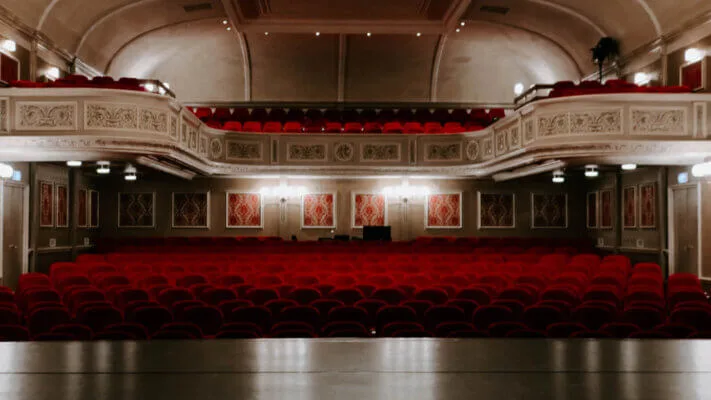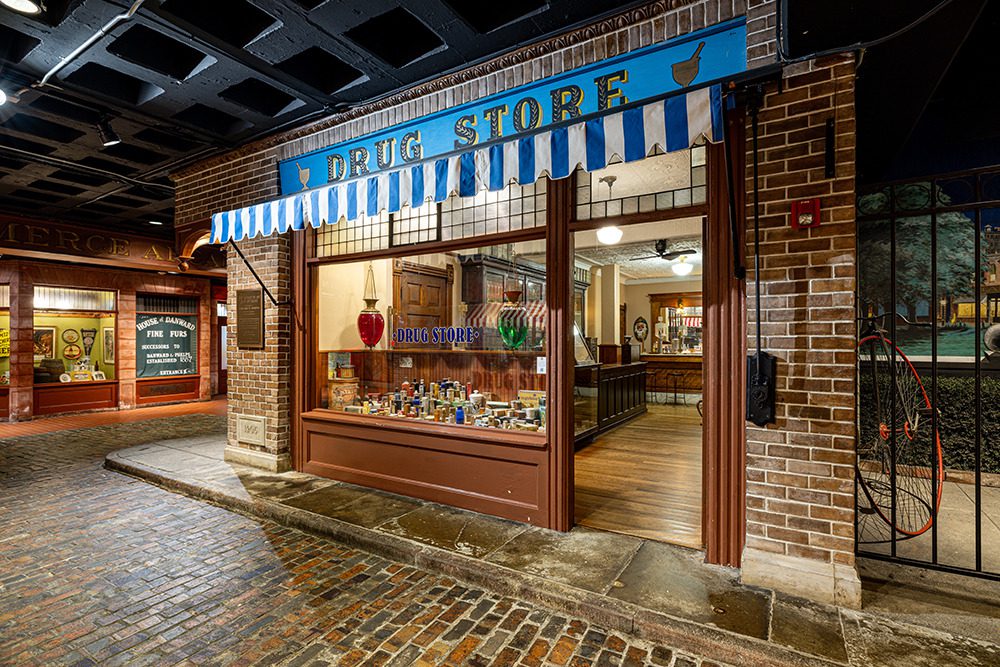
Plenty of historic Michigan theaters are still playing movies and hosting live performances today.
Some heroes don’t wear capes—unless it’s a part of the costume. Then they definitely wear capes. Here are some of the heroes (and heroic organizations and communities) helping Michigan theaters stand the test of time.
MICHIGAN—While today it may be far easier to stream movies onto our devices, movie theaters and live performances can make us yearn for the nostalgia of a simpler time.
The portrait of a historic downtown may also seem incomplete without a historic theater venue of some sort—regardless if that theater is still in operation. Perhaps this is why community groups such as Friends of the Main Art Theater have fought so valiantly to preserve their neighborhood theaters.
Plenty of others are still hosting movies and live performances today—keeping theater culture alive well into the 20th Century. Here are just a few of Michigan’s most beloved historic theaters:
The Croswell (Adrian)

Built: 1886
Seats: 652
Original Architect: Horatio Nelson White
Architectural Style: Neo-Classical
Pre-dating the movie palace architecture boom, the Croswell Opera House is officially Michigan’s oldest theater. But despite the name, the Croswell Opera House has not been used exclusively for opera performances. In its early years, it saw famous names such as Frederick Douglass, Susan B. Anthony, Ralph Waldo Emerson, and John Philip Sousa.
In 1919, purchasers Harry Angell and Robert Codd renovated the Opera House into a movie house. Butterfield Theatres bought it in 1927 and made several other technology changes. They even used movies at Croswell to raise money for the war effort during World War II.
The Croswell Opera House was nearly demolished when Butterfield released the lease contract in 1967, but the theater community rallied to save it. The Croswell Players offered live theater through the rest of the 1960s. From 1970 through 1996, the Croswell also ran a Town Hall series, which included renowned guest speakers such as Ralph Nader, Gloria Steinem, Charlton Heston, Kitty Carlisle and Arianna Huffington.
The Croswell Opera House still hosts live theater performances today.
Visit the website to learn more.
The Calumet Theatre (Calumet)

Built: 1900
Seats: 700
Original Architect: C. K. Shand
Architectural Style: Renaissance Revival
Today, it’s uncommon for too many popular performing acts to venture as far north into Copper Country as the Keweenaw Peninsula. But a century or so ago, this was not the case.
Back in 1898, when the Calumet and Hecla Mining Company was bolstering the local economy with copper mining, the citizens of Calumet decided they needed an opera house. So, the Calumet Theatre became one of the first publicly-owned theaters in the country.
Various groups found their way to the Calumet Theatre stage back in the day, such as John Philip Sousa and Frank Morgan—well before he became famous for playing the eponymous character in Wizard of Oz—and Helena Modjeska, a famous Polish actress whose ghost, depending on who you believe, may or may not have been haunting the stage since 1909.
In the 1920s, Calumet’s economic prosperity declined alongside the copper mining industry. The Calumet Theatre was renovated to display motion pictures in the late 1920s, which remained its primary operation for the next 30 years. By the 1950s, its ownership changed hands several times, but it was saved once again in 1971 when the town declared the theater a national landmark. Immediately after, it received substantial restoration work.
Within a few years, the Calumet Theatre became an impressive part of the expansive Calumet Downtown Historic District. To this day, the people of Calumet still invest greatly in preserving the theater, including charging a “Historic Preservation Fee” with its tickets.
Visit the website to learn more.
The Ramsdell (Manistee)

Built: 1901
Seats: 450
Original Architect: Solon Spencer Beman
Architectural Style: Greek Revival and Colonial Revival
Before the cinema boom, the Ramsdell Theatre in Manistee had garnered a reputation as one of the finest buildings for vaudeville and opera anywhere in the country. But its greatest claim to fame wouldn’t come until decades later in the 1950s, when a then-unknown James Earl Jones started working as a stagehand—only about four years after high school.
At the time, the Ramsdell Theatre was in decline and live theater groups were attempting to revive the old stage. The now-renowned, Emmy Award-winning actor (recognizable as the voice of Darth Vader from Star Wars and Mufasa from The Lion King) first got bit by the acting bug at Ramsdell. The Manistee Civic Players, the in-house live theater group, gave Jones his first gig as the role in Shakespeare’s Othello in 1955. And it was a smash hit.
Jones continued to perform at Ramsdell Theatre from 1953 to 1957 for over 20 productions. After his acting career took off, he returned to Ramsdell in 1993 for the first public signing of his book, Voices and Silences. He has also returned multiple times for fundraising events.
Other members of the Manistee community rallied around the theater in the 90s to help with restoration work—totaling almost $4 million in community love to help keep it alive today.
Visit the website to learn more.
Redford Theatre (Detroit)

Built: 1927
Seats: 1661
Original Architect: Ralph F. Shreive
Architectural Style: Japanese-Inspired Exotic Revival
Unlike many other Michigan theaters, Detroit’s Redford Theatre has been kept in continuous operation only as a movie theater since it opened in 1928. And today, it still keeps history alive by bringing classic films and organ music to the public, with affordable prices to boot.
Back in the day, in-house organs used to provide live music and sound effects to accompany silent films. When the Redford Theatre was built, these silent films were still in production—so it was built with a Barton organ. Today, the theater is one of only a few to retain its original theater organ, and only one of than 10 Barton organs still in existence.
The Redford incorporated Japanese designs into the architecture and interior, including expansive murals. These designs later became undesirable after Pearl Harbor, and most of the decor was repainted, covered up, or outright removed due to anti-Japanese sentiments.
Though the Redford was built during a time of prosperity for Detroit, that prosperity didn’t last long. As Detroit’s population and economy declined, the Redford Theatre was in jeopardy.
It was only through the will of passionate volunteers that the theater kept its doors open. The Motor City Theater Organ Society formed the first volunteer base, but many others have stuck around for decades. To this day, volunteer labor keeps the doors open and the costs low for everyone—as well as helping to restore the original Japanese motifs and artwork.
Visit the website to learn more.
Frauenthal Center (Muskegon)

Built: 1929
Seats: 1800
Original Architect: C. Howard Crane
Architectural Style: Spanish Renaissance
Formerly known as the Michigan Theater, the Frauenthal Theater in Muskegon was intended to be a motion picture venue that could rival the bigger theaters in Detroit. But what the Muskegon community actually ended up getting out of the theater was so much more.
Local movie mogul Paul Shlossman was the brainchild for the eventual Frauenthal Theater. His group, Schlossman Company, held the line there until the late 60s before going belly-up. With Schlossman Company’s end also came the end of the Michigan Theater. But if the story ended here, the Frauenthal Theater would have never made its way onto this list.
The Community Foundation for Muskegon County received a significant gift from local industrialist A. Harold Frauenthal, who instructed the money be used for local good. Hearing the passionate cries of local residents, the Foundation decided to buy the whole block where the Michigan Theater stood on to establish the Frauenthal Center.
Contrary to Shlossman’s original vision for the structure, the Frauenthal Center came to include a wide variety of entertainment—including symphony performances, concerts, and live theater. But there was a lot of work to do to make this old structure viable.
Throughout the 1990s, the Community Foundation lobbied for contributions from Muskegon County bonds for renovations. Eventually, they succeeded and construction began. Today, the Frauenthal Center is a modern gem with top-of-the-line lighting and sound systems.
Visit the website to learn more.
Mission Point Theater (Mackinac Island)

Built: 1955
Seats: 575
Original Architect: William Woolett
Architectural Style: Adirondack
The Mission Point Theater, a part of the Mission Point Resort on Mackinac Island, may be the newest addition on this list but it’s still an integral part of state culture. Plus, it’s the only place to catch a movie on Mackinac Island—which happens to go great with some fudge.
The Mission Point Resort was originally designed as a conference center for the international peace organization Moral Re-Armament and was intended for use by international audiences, complete with headphone jacks and boxes for interpreters. In 1966, the MRA camp was converted into Mackinac College, a liberal arts school where courses in theater, radio, and television were taught, among other things. Its legacy as an educational institution was short-lived, however, and the campus was converted into a hotel in 1977.
If not for the infamous 1979 filming of Somewhere in Time, the Mission Point Theater could very well have become obsolete. The soundstage next to the theater, currently an event hall, was used to film several scenes in the movie. But the theater itself served as the iconic setting for the scene where Christopher Reeve’s character, Richard, listens to the famous monologue of Jane Seymour’s character, Elise. Visitors can still find Reeve’s famous seat in the fourth row, signified with a commemorative plaque. As of 2013, the theater shows a variety of contemporary films outside for anyone on Mackinac Island to enjoy.
Visit the Mackinac Arts Council website to learn more.

That one time in Michigan: When America’s only floating post office set sail
Does the zip code 48222 ring a bell? Unless you have a loved one working on a Great Lakes freighter, probably not. But if you want to send a love...

A historian’s guide to living history in and around Detroit
You’ve studied Michigan history, but why not live it? Check out one historian’s guide to the best ways to bring history to life in Metro Detroit....

That one time in Michigan: When we had our deadliest tornado
June marked the 72nd anniversary of the deadliest tornado in Michigan’s history. Learn about the Flint-Beecher tornado, its impact, and its lasting...

75 years after the then-worst crash in US history, search ends for a plane in Lake Michigan
SOUTH HAVEN, Mich. (AP)—A group is ending a 20-year search for a plane that crashed into Lake Michigan in 1950, killing all 58 people on board,...

A guide to what the Juneteenth holiday is and how to celebrate it
It was 160 years ago that enslaved people in Galveston, Texas, learned they had been freed — after the Civil War's end and two years after President...




